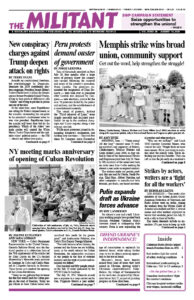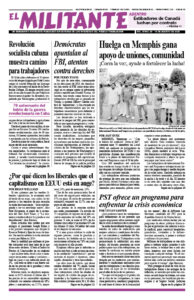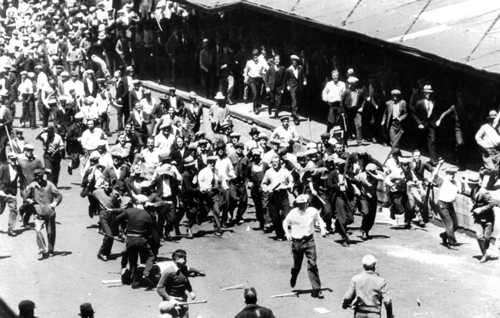As 340,000 Teamster-organized workers at UPS discuss a tentative contract, it is timely that one of Pathfinder’s Books of the Month for August is Teamster Politics by Farrell Dobbs. It is the third in a four-volume series by Dobbs, who emerged from the ranks to be the central organizer of the Teamsters’ 11-state campaign to unionize over-the-road truckers and a leader of the Socialist Workers Party. The Teamsters in Minneapolis, with class-struggle leadership, used union power to beat back boss attacks, extend the union in the Midwest, and help organize other unions as well as the unemployed. They mobilized a union defense guard against boss goons and fascist gangs and led labor resistance to the U.S. rulers’ entry into World War II. The excerpt is from chapter 4, “Dynamics of the labor upsurge.” Copyright © 2015 by Pathfinder Press. Reprinted by permission.
[T]he 1929 stock market crash … heralded the onset of severe economic depression. As the slump deepened, millions lost their jobs. Earnings were slashed for those who still had employment. Working conditions went from bad to worse, as did living standards in general.
At first the workers accepted these blows in a more or less passive manner. They had been stunned by the economic debacle and it took time to recover from the shock effect. Then, when they did begin a quest for ways to defend themselves, only scant means were at hand. Less than three million were organized into the AFL, mainly workers in skilled trades. The great bulk of the working class, especially in basic industry, was not unionized at all. On top of that, the AFL bureaucrats showed no real concern about the plight of the unorganized, whether employed or unemployed. In short, labor was caught in a crisis of organization and leadership.
But limited patterns of struggle gradually began to emerge, characterized by ups and downs in scope and tempo. In the initial stage the actions centered mainly on protest demonstrations by the unemployed. Then, during 1933, strikes broke out here and there in industry, the biggest one being conducted by textile workers. …
Combative moods among the workers continued to grow in intensity, and within the unions radicals were able to increase their leadership authority. As a result, miniature civil wars were fought in 1934 by Minneapolis truck drivers, San Francisco longshoremen, and Toledo auto workers. In each case, labor emerged victorious. Inspired by proof that strikes conducted militantly could be won, the main detachments of the working class in basic industry began to move toward action against the monopoly corporations.
Before the end of 1934 struggles erupted in auto, rubber, and steel. …
This created a new problem for the labor bureaucrats. If these workers were not allowed to organize on an industrial basis, and if they were not given more effective leadership, radicals would soon gain considerable influence among them. Everything would then be up for grabs, including the future of the bureaucrats themselves. …
[A] bloc of unions … split from the AFL in 1936 to form what became the Congress of Industrial Organizations.
With the appearance of the CIO as an independent force, workers throughout basic industry flocked into its ranks and, during 1936 and 1937, a series of bitter struggles followed. These included massive sit-down strikes involving the occupation of plants in total disregard of the alleged “sanctity” of capitalist private property. Action at the scene of battle was guided by broad strike committees. Following the initial contract settlements, committees were elected in the plants to enforce the terms; during the first period of the CIO’s existence these committees were quick to call work stoppages whenever needed to obtain adjustments of grievances. …
Frightened by the breadth and intensity of the developing conflict, the top CIO officials looked from the outset for a way to bring the situation back within class-collaborationist bounds. As a means toward that end they seized upon the 1936 presidential campaign. Steps were taken to center union attention on support of Roosevelt’s candidacy for reelection. That backing, it was hoped, would induce him to use governmental influence to get the CIO a few concessions from the giant monopolies in basic industry, thereby helping to restore more peaceful class relations. …
On the strike front the main CIO battles were yet to be fought, especially in auto and steel. In those clashes — which came in 1937 — the workers would be directly up against major components of the ruling class. This would occur at a time when the capitalists were beginning to prepare for World War II and could, therefore, be expected to put up unusually stiff resistance to the CIO drive.
A potential class showdown was thus in the making, during which the government would become more fully exposed as an agency of the bosses. As a result, more and more workers might be able to see through Roosevelt, clear to his patrician bones.
Developments might also be affected by the labor radicalization then unfolding in Western Europe. Intense class struggles had erupted there, ranging from massive strikes in France to civil war in Spain. If a big advance toward a social overturn were to occur in any of the countries involved, profound repercussions could be expected in the United States. To an increasing degree, workers here would become ready for revolutionary action. A sweeping social conflict might then ensue, leading toward a confrontation over the issue of state power. In that case the way would be open to abolish outlived capitalism, put an end to the injustices it inflicts upon humanity, and proceed to the construction of an enlightened socialist society.
As of 1936, such possibilities definitely existed under the objective conditions then prevailing. Only the further passage of time and events, however, would show whether the implied opportunities could be converted into political reality.
Meanwhile, there was vital need to concentrate on assembling revolutionary cadres, since it takes a party comprised of conscious revolutionists to lead the workers to complete victory.


